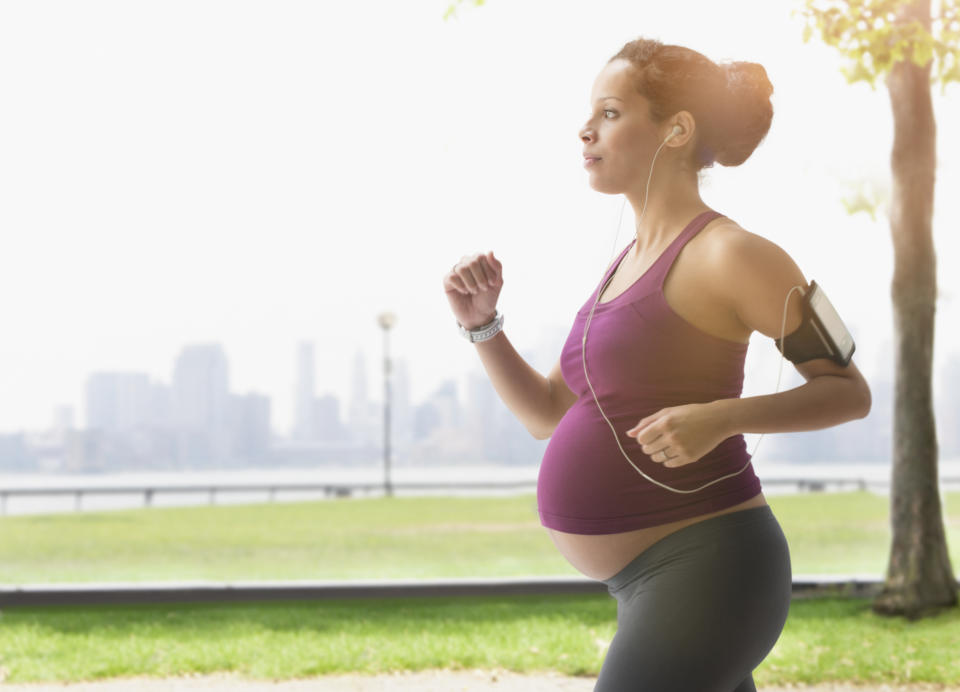Garmin becomes the first – and only – top fitness tracker to offer a pregnancy mode

Garmin has become the first major fitness tracker company to offer a pregnancy mode.
Following pressure from users, Garmin’s smartwatches can now track pregnancy-specific symptoms, give weight gain recommendations, and pause training status.
There are also options to activate high heart rate alerts, manually enter and track baby movement and blood glucose levels, and set up hydration goals or pelvic floor reminders.
According to market research group Kantar, Garmin makes up 9% of the British market share for wearable devices, compared to Fitbit who make up 44% and Apple who make up 18%.
These other two brands dominating the UK wearables market do not have an inbuilt setting on their devices that can be activated if you get pregnant.
Apple and Fitbit devices can monitor heart rate, weight, diet and exercise, but are unable to identify the natural changes that occur during pregnancy.
The omission has been criticised as one of a “long line of oversights” by technology companies.
According to Kantar, in August this year 55% of women in the UK owned a wearable device.
Expecting women’s resting heart rates often increase as their bodies rise in temperature or provide extra blood flow to their baby, and they tend to gain between 10 kg and 12.5 kg in weight.
Rebecca Manson Jones, the Women's Equality Party health spokesperson, told Yahoo News UK: “Fitness trackers either overlook or judge pregnant women who use them, giving potentially incorrect health advice and telling them that their natural weight gain during pregnancy is a problem.
“It is one in a long line of oversights that wears women down and renders them invisible.”
Designed by men for men
As Sara Wachter-Boettcher explains in her book Technically Wrong, apps and algorithms are all too often designed by men and made with men in mind.
Watcher-Boettcher said: “This is classic ‘edge case’ thinking: that pregnant people are outside of the typical usage, and therefore not important enough to design for.
“I think in this conversation, we have to talk honestly about the market pressures and biases that make it very difficult to meaningfully change things.
“It would be great, for example, to see a fitness tracking product designed by a diverse team in a woman-led organisation.”
Read more: Companies use wearable technology to ensure employees social distance at work
Although some wearable devices like the Apple Watch have the option to download third party pregnancy apps, the onus is on women to find and download them.
Pregnant women’s bodies go through a plethora of changes as their baby grows, including changes in their metabolism, weight, heart rate and their immune system, so incorrect information from a wearable device about health may be more than just an unfortunate oversight.
Consultant obstetrician and spokesperson for the Royal College of Obstetricians and Gynaecologists, Dr Daghni Rajasingam, said: “We recommend that fitness trackers do include pregnancy settings so that pregnant women feel better supported when they exercise.
“It would also help to end the data gender gap when it comes to medical research and data collection that currently persists in the UK.”
However Pam Lowe, senior lecturer in sociology at the University of Aston and author of Reproductive Health and Maternal Sacrifice, is not convinced that fitness trackers should be relied on during pregnancy.
She said: “The hormonal cycle of women from puberty to menopause needs to be actively considered if these type of products are to really work properly for half of the population.
“It could be dangerous to have a pregnancy mode giving general advice that cannot fully consider the individual circumstances.”
WATCH: How your Fitbit can tell if you're getting sick
In 2014, Apple was criticised for neglecting to include a menstrual tracker as part of its health app.
More recently, the tech giant has been accused of creating phones too large for women’s hands.
Author and activist Caroline Criado-Perez, who campaigned to have a Millicent Fawcett statue in Parliament Square, wrote on Twitter in 2018: “What the hell is wrong with you, Apple? Women. Buy. Smartphones. In fact, more women buy iPhones than men. DESIGN FOR OUR BODIES.”
Read more: Adidas unveils first maternity activewear collection
Asked whether plans were in place to provide a product for pregnant women, Fitbit failed to commit to offering a pregnancy mode.
A spokesperson for Fitbit said: “Customers on our community forums frequently offer suggestions for new features, and we have seen active discussions around a desire for pregnancy-related settings and features.”

 Yahoo Finance
Yahoo Finance 